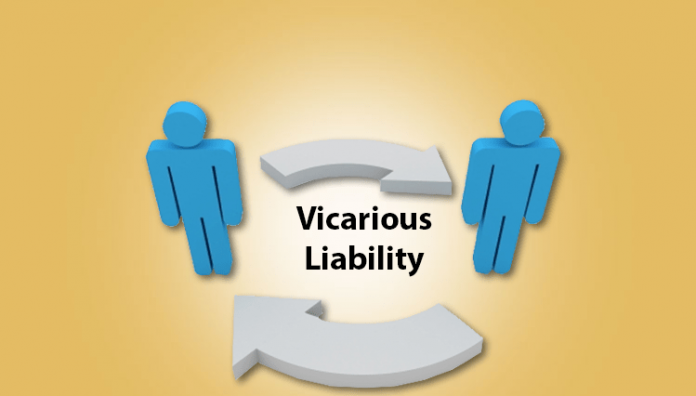This article is written by Shubhangi Sharma, 5th year student of BA LLB in Lloyd Law College, Greater Noida. The articles discuss the vicarious liability of partners in a law firm.
Table of Contents
Principle of Vicarious liability
Generally, a person is liable for his own wrongdoing and one does not bear any obligation for the work done by others. The general rule of vicarious liability is that liability of one person for the act done by another person, may arise. The law refers to this as vicarious liability. For Example, the liability of A for the act done by B can arise, it is necessary that there must be a certain kind of relationship between A and B, and the wrongful act should be, in a certain way, connected with that relationship. The common example of such liability is:
- Liability of principal for the tort of his agent.
- Liability of partners of each other tort.
- The company and its directors.
- Owner and Independent Contractor.
- Liability of the master for the tort of his servant.
Vicarious liability is based on two legal maxims:
Quit facit per alium facit per se
This maxim also applies in the case of principal and agent. When a person authorizes another person to perform a particular task, he becomes the chief and the doer becomes the agent. In this case, the principal becomes liable for the act of the agent. So, this legal maxim of vicarious liability is Quit facit per alium facit per se. It also implies that the employer (or senior) is responsible for the work of the employee.
Respondeat Superior
This legal maxim means “Let the Superior be Liable”. If we have to understand this maxim then we can take a daily life example i.e. we often see seniors sending juniors to seek adjournments or file applications. If the junior is not able to understand the task well, or tries to show his or her legal skills by making some commitment even if not specifically instructed by the senior person, then in that case, the superior is responsible to answer judge and also to clients.
Reasons of Vicarious liability
Several reasons have been advanced as to the justification for imposing vicarious liability:
- The master has the ‘deepest pocket’. The defendant’s funds, or the fact that he has access to resources through insurance, have in some cases had an unconscious effect on the development of legal principles.
- A vicarious obligation encourages accident prevention by giving an employer a financial interest in encouraging their employees to care for the safety of others.
- As an employer makes a profit from the activities of its employees, it must also bear the losses that give rise to those activities.
In Bartanshill coal co. v. McGuire, in this case, the words of Lord Chelmsford, “it has been established by law that a master is liable to third persons for any injury or damage done through the negligence or unskillfulness of a servant acting under his master’s instructions. In such instances, the principle will be liable for the act done by his agent.
Liabilities of a partner to third parties
A partner’s liabilities to third parties are as follows:
1. Liability of a partner for the functions of the firm
Each partner is jointly and severally liable. All partners jointly or individually can be sued by the creditors of the firm.
2. The firm’s liability for the wrongdoing of a partner
If a third party has caused a loss or injury or damage or has been fined due to the partner’s wrongdoing or omission, the firm is equally liable to the partner. However, the partner must act in the ordinary course of business of the firm or with the authority of its partners.
Vicarious liability in employment
The employer may be held liable for actions or omissions during the employee’s job. In the “during employment” act, the employer must authorize or direct the act, or otherwise be associated with the act. An employer is not liable for work done by his employee which is not within the scope of his employment. There are three elements that need to be present for vicarious liability.
- Employment – The person who has committed the tort must be an employee.
- Tort must be committed by one of the partners of the firm.
- Tort must be committed during employment.
The above mentioned elements is needed for vicarious liability can only be established if the person doing the wrong was an employee, and he / she commits the wrongdoing (result in damage and harm to someone), and the wrongdoing was committed during his work when he/she was under the scope of their employer. For example, a water purifier installation engineer comes into your home, but is the installation so bad that the exterior and interior walls need to be repaired. In this instance, the employer has not actually done anything wrong, but would still be liable under vicarious liability. And the above example also includes the 3 elements also i.e. employment, during employment, commitment of tort that must exist for obligation.
Similarly, a wrongful act is done by one partner in the ordinary course of business of the firm; all the other partners are vicariously liable for the same. All the partners of the firm i.e. guilty partner and the others are considered to be the joint tortfeasor. This liability is joint and several.
Joint and several liabilities
When two or more parties are jointly and severally liable for vicarious acts, each party is independently liable to the full extent of the injuries. Thus, if a plaintiff collectively wins a money judgment against the parties, the plaintiff can collect the full value of the judgment from both. That party can then seek damage as contributions from other wrongdoers. This concept of choosing the defendant (s) from which to collect damages is called the law of Indivisible Injury.
Illustration: Suppose that A, B, and C negligently injure V. V successfully sues A, B, and C, for 20,000 rupees. If the court used a joint and several liability system, V could demand that A pay V the full 20,000 rupees. A could demand contribution from B and C. However, if B or C could not pay, A would be stuck paying the full amount which is demanded by V.

Who are partners in a firm?
A partnership firm is a type of business in which a group of people, also known as partners, come together. They establish their own firm and provide services and products through it. However, a partnership firm is not considered as a separate legal entity. The partners share all profits and losses among each other. All partners are given unlimited liability. To become a partner in a partnership firm one must attain some requirements which are mentioned below. One can enter into a partnership by the following law:
- A person
- A firm (recognized by law as a separate legal entity.
- A company
- A trustee
- Chief member of a Hindu undivided family (Karta)
Partners relationship
The relationship which partners share with each other is the same as in principle and agent. For the tort committed by any of the partner of the company, all partners will be held liable for the damages. The liability of each partner is joint and several.
Under the Indian Partnership Act, 1932, the most important sections are:
Section 4 deals with the definition of partner.
Section 6 deals with mode of determining the existence of partnership.
Section 13 defines mutual right and liabilities.
In a Partnership firm each partner acts on behalf of other partner or on behalf of partnership. Hence, a partnership can be held vicariously liable for negligence committed by a partner. Consequently, the partnership may be held liable for the loss or injury of client.
Case laws
In the case of Northampton Regional Livestock Centre Company Ltd. v. Cowling is a reminder of the potential liability of partners of a general partnership. In this case, a partner (Partner A) jointly or severally liable for his partner’s (Partners B) breach of fiduciary duty pursuant to section 10 of the partnership acts, 1890. The court of appeal, overturning the first instance decision, was clear that although partner’s A conduct was reasonable and he had neither acted negligently nor authorized partner B’s breach of duty, the principle of joint and severally applied.
In the case of, Redman v. Walter, The plaintiff, Redman, employed the law firm, MacDonald, Brunsell & Walters, to prosecute a lawsuit. His suit was filed with “MacDonald, Brunsell & Walters” as attorneys of record.22 The suit was later dismissed, however, for failure to come to trial within five years, as required under the California Code of Civil Procedure. Walters, one of the members of the firm employed by the plaintiff, had severed his relationship with the firm ten months from the date of initial retainer.24 Nevertheless, Redman instituted a negligence action against the partnership, MacDonald, Brunsell & Walters, and each attorney individually. the court stated that “generally, all partners are bound by the acts of any one, within the legitimate scope of the business of the partnership, until the dissolution of the partnership.
In case of Smt. Vunna Visali v. State of A.P., It was held that In fact, every partner is liable for an ‘act of the firm’. ‘Act of a firm’ has been defined to mean ‘any act or omission by all the partners or by any partner or agent of the firm which gives rise to a right enforceable by or against the firm’. This is the civil liability of the firm and its partners.
Partners and Partnership
Each firm partner is the agent of the other for partnership purposes business. The act of one partner is called the act of all. “First and foremost issue, is that in a malpractice suit, alleging vicarious liability of a law partnership, is whether there was an existence of partnership at the time the alleged liability arose. Therefore, all other partners are held liable for the wrongdoing of one partner of a business firm to the same extent as the guilty partner. In the case of Hamlin v. Houston & Co., one of the partners of the partnership firm bribed the plaintiff’s clerk to give secret information about the plaintiff’s business. It was held that both partners of the firm could be held liable for preventing breach of contract, which is a wrongful act, although the act was committed by one of them.
Conclusion
Vicarious Liability deals with cases where one person is liable for the acts of others. In the field of Torts it is considered to be an exception to the general rule that a person is liable for his own acts only. The principle of vicarious liability is based on the principle of qui facit per se per alium facit per se, which means, “He who does an act through another is deemed in law to do it himself.” Hence, in the case of vicarious liability, both the persons on whose instructions the act is carried out, as well as the person implementing the act, are liable. Thus, employers are strictly responsible for the act of their employees committed during employment. In the order that A’s liability for actions done by B may arise, it is necessary that there must be some kind of relationship between A and B, and wrongly, in a certain way, related with that relationship. So, a master is liable for the acts of his servant if the act is done in the course of employment. But where one appoints an independent contractor to do the work on his own behalf, he is not responsible in any general way for any act committed by the contractor during the execution of the work except in some exceptional cases. The vicarious liability of a law partnership is essentially analyzed in two stages: first, whether the partnership is in existence or real; And second, wrongdoing / work done within the partner in simple course of business, in the existence of law partnership.
 Serato DJ Crack 2025Serato DJ PRO Crack
Serato DJ Crack 2025Serato DJ PRO Crack










 Allow notifications
Allow notifications



